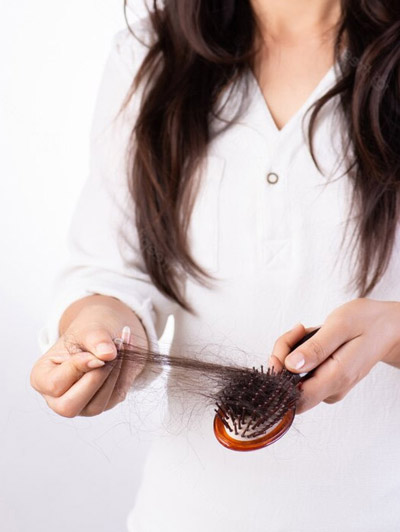Say goodbye to your hair fall woes with help from Hairrich Hair Restore Center, the finest hair clinic in Kurnool. We aim to provide quality services that reduce hair fall and boost hair growth.
Nowadays, Hair loss is a very common problem in both men and women. Almost everyone experiences hair loss at some point in their lives. Hair loss occurs in 70-80% in men and 50-60% in women. Hair loss can affect the scalp or the whole body. Hair loss is also known as alopecia or baldness. Hair loss can be temporary or long-standing, based on its identification, cause, and treatment. Moreover, the hair loss that was first temporary may become permanent as a result of incorrect diagnosis, care, and treatment. Although hair loss doesn’t cause a threat to your health or life but can cause devastating effects on your self-image and sense of well-being. Hair loss can be a prime indicator of underlying chronic or serious health issues.
Hair grows everywhere on the human skin except on the palms and soles. Hair is made up of a protein called keratin, which is produced from the hair follicles in the outer layer of the skin. As follicles produce new hair cells (new hair), old cells (old hair) are being pushed out through the surface of the skin at the rate of about six inches a year. The hair which is seen outside is actually a string of dead keratin cells.
The average adult head has about 1 to 1.5 lakh hair and loses about 100 hairs each day. This is normal hair a person loses usually, and their hair grows back. But in most men and some women lose hair as they grow older. At any one time, about 90% of the hair on a person’s scalp is in the growing stage. Each follicle has its own life cycle that can be influenced by age, disease, and a wide variety of other factors.
Normally, hair goes through a regular growth cycle. This regular growth cycle or life cycle is divided into three phases:
Anagen phase: is active hair growth that lasts between two to six years, the hair grows.
Catagen phase is transitional hair growth that lasts two to three weeks.
Telogen phase: is a resting phase that lasts about three months; and at the end of the telogen phase, the hair falls out and replaced by new hair (and the growing cycle starts again).
With ageing the rate of hair growth slows down.
Hence, Hair loss occurs when this cycle of hair growth and shedding is disrupted or when the hair follicle is destroyed and replaced with invisible scar tissue.
Hair is an essential component of the human body. It works as a defensive structure to our body.
Excessive tight hairstyles, such as braids, buns, or ponytails can cause traction alopecia or hair loss. Hot rollers, curling irons, hot oil treatments, and permanents can permanently damage hair follicles.
Compulsively twisting, rubbing, or pulling your hair. Combing, brushing or applying plastic or rubber hair ties on your wet hair.
Hence, it is important to identify the root cause of the hair loss problem and to correct it in time.
However, in men, hair often begins to recede from the forehead in a line that resembles the letter’ M’. Women typically thin throughout the top of the scalp and leaving the frontal hairline intact.
The above signs and symptoms of hair loss are a matter of concern and one needs to restore their hair by consulting a dermatologist.
With the period of time, the symptoms of hair loss can be traumatic and the psychosocial impact of hair loss can be severe for the sufferers. Hair loss can cause dramatic and devastating emotions which can negatively impact their quality of life. The negative quality of life seems to be worse in women. The known psychosocial complications include depression, low self-esteem or self-confidence, altered body or self-image, and unusual social engagement.
Hair loss can appear in many different ways, depending on what’s causing it. It can come on suddenly or gradually and affect just your scalp or your whole body. Some types of hair loss are temporary, and others are permanent.
Hair loss other than age-related (involutional alopecia) is further classified into two major categories: scarring and non-scarring hair loss. Most commonly it is age-related hair thinning or male or female pattern balding is common.
In general, scarring hair loss is permanent hair loss. Scarring hair loss is two types primary and secondary. Primary alopecia arises from a process that originates from the hair follicles, whereas secondary scarring alopecia is due to all other causes of underlying scalp involvement. Non-scarring hair loss which we commonly come across can include patchy hair loss or alopecia areata, telogen effluvium, and so on.
Alopecia is the medical term for excessive or abnormal hair loss.
Primary:
Secondary:
As ages, the rate of hair growth slows, resulting in a reduction of the volume and thickness of hair. Here the hair follicles gradually enter the resting phase and the remaining hair becomes shorter and less in number, sometimes even brittle.
Permanent hair loss from the scalp, causing baldness. However, in men, hair often begins to recede from the forehead in a line that resembles the letter’ M’. Women typically thin throughout the top of the scalp and leaving the frontal hairline intact.
A reversible condition in which temporary hair falls occurs due to stressed episodes like childbirth, severe illness, fever, sudden mental stress, or weight loss. This results due to abrupt changes in the growth cycle of hair, where a large number of hairs go into the resting phase.
It is an abnormal hair loss during the first phase or growth phase of the hair lifecycle that occurs as the result of exposure to chemicals or toxins or cancer treatments.
There is a sudden hair loss that may start as circular or coin-sized patches on the head and or face.
Due to traction on hair because of particular hairstyles causing small, localized areas a type of hair loss, particularly involving the hairline.
This is also referred to as hair-pulling disorder. The individual with psychological disturbances has the habit of twisting or pulling their own hair from the scalp and eyelashes.
There are various treatments available to treat hair loss. The early and right treatment during the process can slow further thinning or reverse hair loss.
Treatments for hair loss include medications, interventional therapy such as procedures like mesotherapy, platelet-rich plasma (PRP) therapy , micro-needling (derma roller) , low-level laser light therapy (LLLT) and surgery to promote hair growth and slow hair loss.
Changes in lifestyle and natural home remedies can help hair loss.
There are few tips which can help to avoid preventable types of hair loss:
Most baldness, male or female is caused by genetics which is not preventable but early and right treatment with above preventable measures can slow down the thinning and reverse the hair loss.

